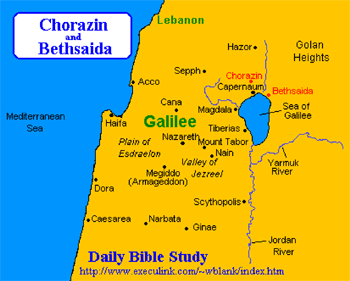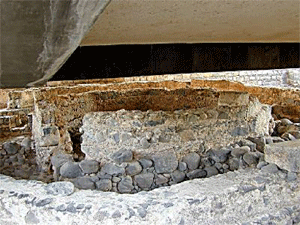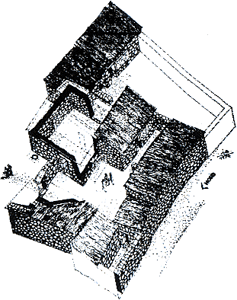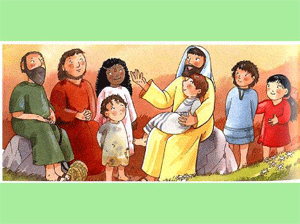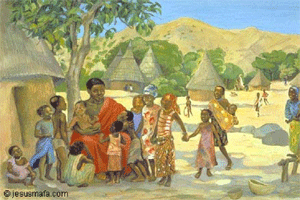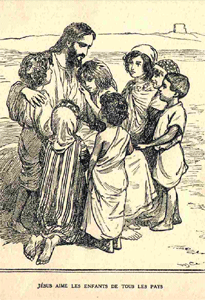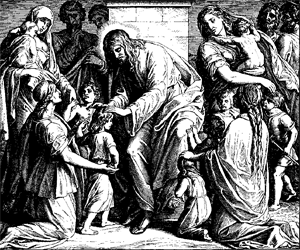
Christmas
Easter
Pentcoest
All Saints
Christ The King
Confirmation
Palm/Passion
Reformation
Stewardship
Books of the Bible
Lenten Series
Christmas Dramas
Videos
Series A - Matthew
Series B - Mark
Series C - Luke
Series D - Other
To contact
Edward F. Markquart
info@sfs.com
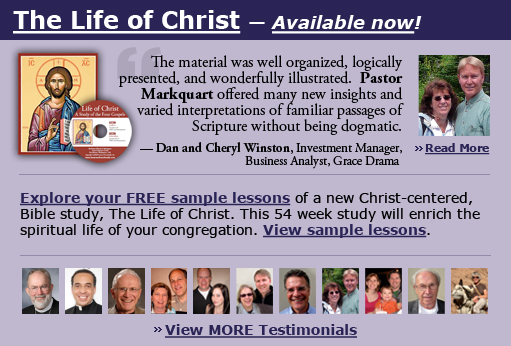
Series B PENTECOST 16B Mark 9:30-37The following Bible study is from a larger course entitled, THE LIFE OF CHRIST: A Study in the Four Gospels. This 54 week course for the laity will be available for congregations in 2006. Basic text for the course: SYNOPSIS OF THE FOUR GOSPELS, Kurt Aland, English Edition, pp. 157- 159. Introductory Comments As a preacher who faithfully uses the lectionary, it is prudent to use the lectionary wisely. As a seasoned pastor and veteran preacher, I think it is wise be a textual/thematic preacher. A preacher preaches on the text and also finds a specific/central theme in that text. For me as a seasoned preacher, it is wise to preach on the theme of “Jesus and his love of children” on Pentecost 16B. On Pentecost 16B, a preacher could focus on the phrases e.g. Mark 9:36-37, “Then he took a little child and put it among them; and taking it in his arms, he said to them, ‘Whoever welcomes one such child in my name welcomes me, and whoever welcomes me welcomes not me but the one who sent me." A preacher could then supplement this text with Mark 10:13-16 from Pentecost 18B, “People were bringing little children to him in order that he might touch them; and the disciples spoke sternly to them. But when Jesus saw this, he was indignant and said to them, "Let the little children come to me; do not stop them; for it is to such as these that the kingdom of God belongs. Truly I tell you, whoever does not receive the kingdom of God as a little child will never enter it." And he took them up in his arms, laid his hands on them, and blessed them.” These two texts and two incidents about children can be brought together in one sermon. On Pentecost 18B, Mark 10:2-16, a preacher could focus on the theme of “marriage and divorce” but not on that portion of the text about children. The portion of that text about children would supplement the sermon on Pentecost 16B, and “Jesus’ love of children.” On Pentecost 20B, a preacher could focus on the theme of “being a servant” which is found both in Pentecost 16B (Mark 9:30-37) and Pentecost 20B (Mark 10:35-45). The theme of “being a servant” is central on both Sundays. Pentecost 16B/Mark 9:33-37: “But they were silent, for on the way they had argued with one another who was the greatest. He sat down, called the twelve, and said to them, "Whoever wants to be first must be last of all and servant of all." Pentecost 20B/Mark 10:43-45: “Whoever wishes to become great among you must be your servant, and whoever wishes to be first among you must be slave of all. For the Son of Man came not to be served but to serve, and to give his life a ransom for many." These two texts about “being a servant” can be brought together in one sermon. For an analysis of the theme, "being a servant," which is at the heart of the text for both Pentecost 16B and Pentecost 20B, please see the following analysis for Pentecost 20B: Pentecost 20 Gospel Analysis # 164. Jesus Foretells His Passion Again Matthew 17:22-23, Mark 9:39-32, Luke 9:43b-45 -They went on from there and passed through Galilee. The “there” in this sentence refers to Jesus having been up north in the region of Caesarea Philippi and Mount Hermon. Jesus now arrived back in Galilee. Matthew emphasizes that the disciples were in Galilee again. -Let these words sink into your ears. Only in Luke. We too want the words of Jesus to finally sink into our ears and penetrate our minds, hearts and habits. -The Son of man will be delivered into the hands of men, killed and after three days, he will rise/be raised. These concepts were totally perplexing for the disciples. They could not begin to fathom the suffering of the Messiah nor could they fathom the resurrection. -They did not understand the saying. That was true of his first disciples and is often true of his disciples today. This saying is also found in Luke. Underline it in Luke. -It was concealed from them and they did not perceive it. Only in Luke. -The disciples were afraid to ask him about this saying. We assume that the disciples remember what happened to Peter when Peter didn’t accept this teaching of Jesus. Jesus had already said to Peter, “Get behind me Satan. You are on the side of people rather than God.” The disciples just kept their mouth shut on this one, wondering what this teaching meant. But we contemporary disciples know that Jesus, the Son of God, was destined to suffer and die on the cross for our sins and to give us everlasting life. We contemporary disciples know that it was his destiny to die…and rise again. #166. True Greatness Matthew 18:1-5, Mark 9:33-37, Luke 9:46-48 -When he came to Capernaum Note the location of Capernaum below. Notice that Chorazin and Capernaum were neighboring villages. Both villages had millstones. In next week gospel lesson, we will hear about the millstones that were part of Chorazin.
-And when he was in the house. We are clearly back to Capernaum again and we are in “the house” again. Turn to, Mark 2:1, “When he returned to Capernaum after some days, it was reported that he was at home…they let the paralytic down through the roof.” Turn to, Mark 1:29, “He left the synagogue and entered the house of Simon (Peter’s house).” Notice that the gospel parallels refer to Simon’s house. Notice that the “door” of the house is referred to in several anecdotes e.g. people were crowded around the door of the house. A reader certainly feels as of he/she is reading an eyewitness account of the story. We recall the photographs and images from Lesson 7: The House of Peter. Excavations revealed one residence that stood out from the others. This house was the object of early Christian attention with 2nd century graffiti and a 4th century house church built above it. In the 5th century a large octagonal Byzantine church was erected above this, complete with a baptistery. Pilgrims referred to this as the house of the Apostle Peter. http://www.christiananswers.net/abr/home.html
Archaeological drawing of a home similar to Peter's house as it may have appeared during the time of Jesus.
-Jesus asked them what they (the disciples) were discussing on the way. But they were silent for on the way they had discussed/argued with one another who was the greatest. The Gospel of Mark once again gives us these spicy details. In Mark’s gospel, the disciples, while up north on Mount Hermon and the Mount of Transfiguration, were separated into two groups: Peter, James and John who went to the top of the mountain to experience the glorious transfiguration of Jesus and the other nine disciples who remained below and could not even cast out the demon in the “lunatic” boy. On the walk home, we would not be surprised that the disciples got into an argument as to which disciples were the greatest. Who were thee greatest disciples? The three disciples who were on the top of Mount Hermon and saw the glorious Transfiguration? Or, the nine disciples who could not cast out the demon from the boy who had seizures! Luke says, “An argument arose among them as to which of them was the greatest.” Luke’s account suggests that there were strong feelings expressed among the disciples about who were the greatest disciples.
-He/Jesus sat down and called the twelve. We remember from previous lessons that the position of a teaching rabbi was to be seated. The story teller, Simon Peter, was an eyewitness of this event and he recalled that Jesus sat down on the floor of the house and called the twelve disciples around him...and began teaching again. -If anyone would be first, he must be last of all and servant of all. (Only in Mark) We previously studied this teaching of Jesus when we examined the characteristics of discipleship. Jesus himself was a servant and invited his disciples to be servants. We recall Jesus’ other similar teachings such as in Mark 10:35-45. We remember Jesus’ foot washing at the last supper in the Gospel of John where Jesus washed all the disciples’ feet as an example of the way that they were to live and serve. We remember Paul’s words in Philippians 2:6ff, “For Christ did not count equality with God a thing to be grasped, but he humbled himself, taking the form of a servant.” We remember that the Apostle Paul would regularly begin his letters, “From Paul, a servant of Jesus Christ.” We know that his followers were described as “Christians” only once in the New Testament but they were described as “servants” innumerable times. Later, on page 225, we will study Mark 10:35-45 where James and John thought that they should be regarded as more important than the other disciples. We recall the story where John and James thought that one of them should be at Jesus’ left hand and the other at his right hand. A reader senses the event of the Transfiguration “had gone to their heads” (an American colloquialism) and these two disciples were inflating their importance. The other ten disciples were indignant at James and John for wanting to be elevated above them. Jesus then taught the following words (Mark 10:43): “Whoever would be great among you must be your servant. Whoever would be first among you must be slave of all. For the Son of man came also not to be served but to serve and give his life as a ransom for many.” The thrust of this teaching in Mark 10:35-45 is identical to his teaching herein Mark 9:33-37, the text we are examining. -And he/Jesus took a child and put him in the midst/by his side. Jesus’ teaching about the spirit and humility of a child fits naturally into this gospel story. It appears that Peter, James and John, who experienced a miraculous mountaintop event, used that event to elevate themselves above the other disciples. The other nine disciples did the opposite. They other nine perhaps blamed themselves for not being able to heal the lunatic boy. The other nine may have begun to doubt the quality of their own faith. The other nine may have begun to compare themselves to the “big three” who experienced the Transfiguration and saw themselves as having lesser faith than the “big three” disciples. Both sets of disciples were wrong. Both sets of disciples were into the “mind games” of “superiority” and “inferiority.” Disciples are not called to think we are superior or inferior due to experiences beyond ourselves. Rather, all of us disciples are to become like little children who are humble and trusting. Disciples of Jesus are not to play adult “mind games” of superiority or inferiority based on class, wealth, education, giftedness, religion, or religious experiences. Rather, disciples of all centuries are called to have the humility of children and be servants of Christ and one another. -And taking him in his arms. This presupposes the child is a small child, if the child can be taken into arms of Jesus. We will see that Jesus also took the children into his arms in Mark 10:6. These children must have been small children to be taken into the arms of Jesus. That is, normally, a parent can lift a five year old into his/her arms but not an eight year old. Again, this is an eyewitness account of an event which actually happened in Jesus' life. We can visualize Jesus taking a child and enfolding that child into his arms. -Unless you turn and become like children, you will not enter the kingdom of heaven. Whomever humbles himself like this child is the greatest in the kingdom of heaven. (Only in Matthew) For Matthew, a child symbolizes humility and not thinking of yourself as being more valuable than others. -Whoever receives/welcomes one such child in my name receives/welcomes me. God’s children are all around the earth, and whenever one receives/welcomes a child, one receives/welcomes the presence of God. A child becomes the very presence of Jesus. -Whoever receives me, receives not me but him who sent me. When you help children, you receive not only Christ but God who sent Christ. When you help a child, you are helping God. -He who is least among you all is the one who is the greatest. (Only in Luke) Who is the greatest person in our contemporary American society? Normally, it is people with the most money, most brains or most prestigious jobs. Normally, we cater and defer to such people. But Jesus turns the values of society upside down and says that the greatest person in the world is a person who is humble and does not think of himself/herself more highly than others. Both Luke and Matthew say that that greatest person in the kingdom of God is the person who is humble. In ancient Biblical society, the “least of these” would have included children. Children are least because they are small and easily controlled and manipulated by the power of adult size, adult experience and adult material resources. In first century Biblical society, children were at the bottom of the totem pole and were part of the “least of these.” For a sermon on this text about "being a servant," see: Pentecost 16 __________________________________________________________________ The following material supplements the gospel text for Pentecost 16B. Mark 10:13-16 is part of the appointed lectionary text for Pentecost 18B about marriage and divorce. This passage in Mark 10:13-16 about blessing the children fits more naturally with the text for Pentecost 16B (whoever receives a child in my name) than Pentecost 18B (divorce and marriage). As a preacher, I would use Mark 10:13-16 as part of the sermon for this coming Sunday rather than in two weeks in the sermon which focuses on divorce and marriage. #253. Jesus Blesses The Children (P. 216) Matthew 19:13-15, Mark 10:13-16, Luke 18:15-17 We will now study this second teaching of Jesus concerning children. We will also study it later in the Jesus Story when Jesus begins his ministry in Judea. The same incident is reported in the first three gospels in parallel form. This scene has become immortalized in our minds and we can easily visualize the situation. -They were bringing children to him that he might touch them/lay his hands on them. We hear that the children were being brought to Jesus. That presupposes that parents were bringing their children; these children were not old enough to come on their own. We already know Jesus’ teaching that the greatest person in the kingdom of God is the person who has faith like a child. Jesus wanted to lay his hands on the children, touch them, and bless them. We recall Jesus touching others who were sick as he healed them. There was and is power in “gently touching” other people, both in Jesus’ day and today. We recall other of Luke’s stories about Jesus touching the leper, touching the son of the widow at Nain, and touching the high priest’s servant’s ear (which was sliced off on Holy Thursday night.) We recall other gospel stories when Jesus touched the ears and tongue of people who were sick. There was power in Jesus’ touch, power to heal and restore. Today, Christian parents still bring their children to the altars of churches in order that a pastor or priest, who is a representative of Christ, might touch and bless them. -Even infants. (Only in Luke) Denominations, which practice infant baptism, use this text as an illustration of Jesus’ pointing to infants as an example of infants belonging to the kingdom of God. Infants and children are fully part of the kingdom. Infants and children are not to be denied entrance to the kingdom. Jesus teaches that adults are to become trusting like children, and then adults will begin to understand the nature of the kingdom of God. We understand from experience that children, early in infancy, initially learn to trust the mother and then the father. That simple trust is an irreplaceable foundation for living. Jesus wants us to have the same quality of trust in our Heavenly Father as an infant has towards his/her mother or father. We define having faith/ belief (the same Greek word) as having that primary quality of trust. Faith is trust. Trust is the first elementary emotion that healthy human beings learn. The Greek word for “infants” is “breefay.” This Greek word is used six times in the book, Luke-Acts. “It means ‘baby, infant’ either in the womb or after birth.” See Luke 1:44, page, 3, “the babe in my womb leaped for joy.” (Just, page 686). We also know that an infant learns trust while in the womb of the mother, even prior to birth. Near the words, “even infants,” write in the following phrase: “This phrase supports infant baptism.” -The disciples rebuked them. The disciples once again misunderstood Jesus’ teaching, including his perception that people who had the faith/trust of little children were greatest in the kingdom of God. We previously heard about Jesus “rebuking” demons, fevers, wind, waves and storms on the Sea of Galilee. We also heard that Jesus rebuked his disciples for telling people that he was the Messiah. The word, “rebuke,” is a strong word, and in this instance, it is the disciples who rebuked the parents of the children and perhaps the children themselves. -When Jesus saw it, he was indignant and said to them. Once again, Jesus became upset with his disciples. Parents from all generations who have noisy and restless children are appreciative of this story. Parents smile when Jesus becomes indignant at the fussiness of the disciples and not at the fussiness of the children. -Let the children come to me and do not hinder them. Do not prevent the children from coming to me. One of the worst sins that disciples could commit was to prevent/stop/inhibit people from coming into the kingdom of God. It is interesting that Luke uses the word for “hinder” or “prevent” twice more in Luke-Acts. In Acts 8:36, the Ethiopian eunuch asks what is to prevent him from being baptized. In Acts 10:47, Peter asks what is to prevent Cornelius and his household from being baptized. Some Jewish Christians (who were more Jewish than Christian) wanted to prevent black castrated males (Ethiopian eunuchs) from entering the kingdom of God and being baptized. They also wanted to prevent a Gentile centurion (Cornelius) and his family from entering the kingdom of God and being baptized. (Just, page 690). Similarly, some disciples would prevent infants and little children from entering the kingdom of God. Jesus commanded: “Do not hinder or prevent the children from entering the kingdom.” Mainline denominations would also say: “Do not hinder or prevent children/infants from being baptized.” Write in the margins of your book: “This story is a primary argument for infant baptism. Do not deny children/infants from being baptized.” -For to such belong the kingdom of God. Children and those people who have the hearts of children are part of the kingdom of God. In fact, we know that children and those with the hearts of children are greatest in the kingdom of God. Children are symbolic of at least three qualities: trust, obedience and humility. -Whoever does not receive the kingdom of God like a child shall not enter into it. The way into the kingdom is to have the heart, eyes and trust of a child. It is important to have this elementary trust in the loving mercy of God the Father. -He took them into his arms, Notice that in Mark 9:36, page 158, Jesus took the child into his arms. In both Mark 9:36 and Mark 10:16, Jesus took a child/children into his arms. Matthew and Luke do not have that detail of Jesus welcoming children into his arms. The phrase, “took them into his arms,” presupposes younger children who could be enfolded into his arms. This account by Simon Peter via John Mark feels like a juicy detail by an eyewitness who personally observed the event of Jesus bringing little children into his arms. -And blessed them, laying his hands on them. Jesus laid his hands on the little children and blessed them. Today, parents of children and children themselves love to receive blessings from their pastors. Parents often feel that their pastors are representatives of Christ. To receive a blessing from the pastor is like being touched indirectly by Jesus Christ. During Holy Communion, younger children often receive a blessing from their pastor. The pastor makes the sign of the cross on a young child’s head and speaks a special word of blessing to an infant or young child. This event is sacred for many children and their parents.
http://www.jesusmafa.com/anglais/imag41.htm
CHILDREN TEACHING Mk 09:33-37 // / ALTIS ARMEE DU S,20,FRA,1930 http://membres.lycos.fr/imagedart/images/mc09a/index.htm
http://www.wels.net/wmc/Downloads/203.gif
|
||
